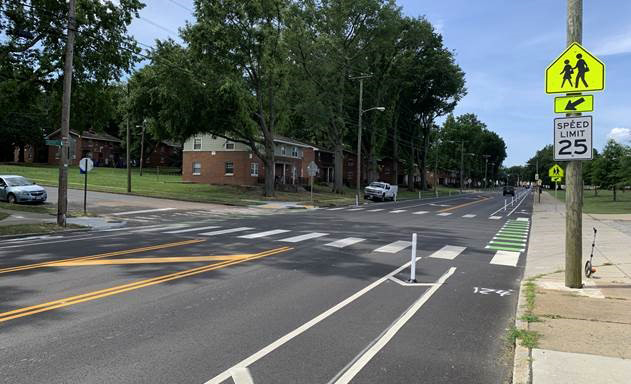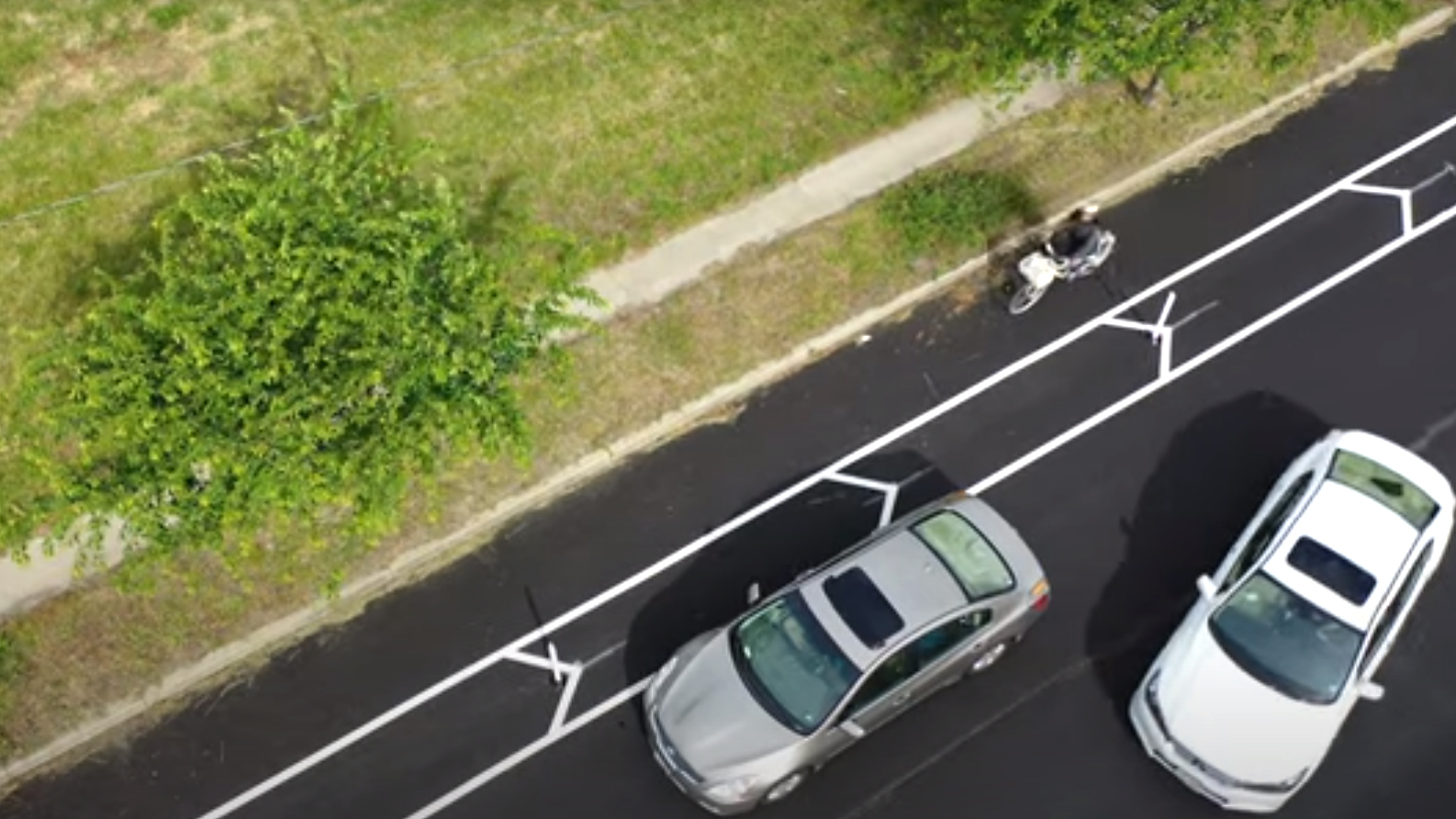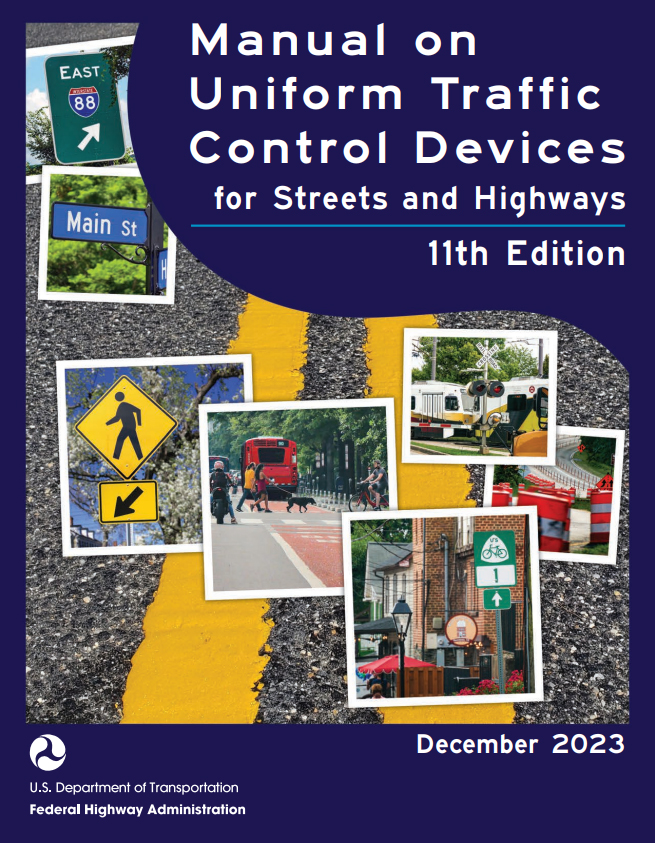Most fatal and serious injury bicyclist crashes occur at non-intersection locations. Nearly one-third of these crashes occur when motorists are overtaking bicyclists and the speed and size differential between vehicles and bicycles can lead to severe injury. In many areas, people are not comfortable riding a bicycle due to their discomfort riding too close to traffic.
One approach to making roadways safer for bicyclists is adding separated bike lanes. Separated bicycle lanes are those that use a buffer space with vertical elements—such as flexible delineator posts, curbs, or vegetation—between the bicycle lane and motorized traffic lanes. This approach recognizes the vulnerability of bicyclists and aligns with the Safe System Approach—separating road users in space can enhance safety for all.
Separated bicycle lanes can mitigate or prevent interactions, conflicts, and crashes between bicyclists and motor vehicles. In fact, converting traditional bike lanes to a separated lane with low-cost flexible delineators can reduce bicycle-vehicle crashes by up to 53 percent.
With this being the case, then why aren’t separated bicycle lanes more common?
From the 1950s to 1970s, most transportation professionals concentrated on the motor vehicle network. However, interest in bicycling was increasing, which led to the development of the first national design guidance, the 1974 edition of the American Association of State Highway and Transportation Officials (AASHTO) Bike Guide. That first edition recommended bike lanes that were separated both from vehicles and pedestrians. However, some advocates promoted designs that would serve accomplished and confident bicyclists only. Subsequent editions of the AASHTO guide reflected this influence and affected design practices for decades to come. In recent years there has been impetus to better address the needs of all ages and abilities in bikeway networks. Cities and organizations like the National Association of City Transportation Officials have prompted changes in practice. FHWA released its Separated Bike Lane Planning and Design Guide in 2015. The recent update to the Manual of Uniform Traffic control Devices for Streets and Highways (MUTCD) gives greater consideration to all road users and incorporates standards for traffic control devices on separated bike lanes.
“Bicyclists are vulnerable, but much of our past guidance did not include the practices that we now recognize as the Safe System Approach,” said Brooke Struve, FHWA Resource Center. “If bikeways have been included at all, they have often been a lane of minimal width placed next to high-speed traffic. The Safe System Approach tells us that bicyclists need to be separated, they need their own space. Research confirms that this will reduce severe crashes. We have design guidance, like FHWA’s Bikeway Selection Guide, and look forward to more guidance that is currently under development.”
If a community decides to provide bike lanes or a designated pedestrian area separated from vehicles, FHWA’s Bikeway Selection Guide tells agencies which type of bikeway may be most appropriate for the context. The MUTCD tells agencies which traffic control devices are needed to communicate that to all road users. New crash modification factors reveal the safety benefits.

Richmond, VA, has been working to implement separated bike lanes throughout the city.
Credit: City of Richmond, VA
Separated Bike Lanes in Practice
At the start of 2011, Richmond, VA, had a total of 8 miles of bike lanes. At the start of 2024 and over a decade of focus, this mid-sized American city has a network of more than 70 miles, most of it buffered or separated from vehicle traffic.
Richmond is driven to reach its Vision Zero goals by 2030, and a robust bike lane network is an important part of its work. Roadway conversions have not only proven a good tool for crash reduction, but they have also given Richmond opportunities to install a variety of bike lanes within existing right-of-way. After its Bike Master Plan was created in 2015, Richmond now builds buffered bike lanes on select urban arterials, implementing many of them in coordination with its pavement maintenance program. This approach, rather than relying solely on State and Federal funds, saves both time and money.
Richmond applies an equity lens citywide, with a particular emphasis on the High Injury Street Network and historically marginalized communities through its Path to Equity policy document. Richmond’s first separated bike lanes appeared in 2018 near a disadvantaged public housing community where a four-lane, median-divided road allowed for the implementation of a parking-separated bike lane. The conversion enhanced the space for people who bike and reduced crossing distances and exposure to crossing threats for people who walk, regardless of age or ability.

This design uses parking as an additional layer of separation between traffic and bike lanes.
Credit: City of Richmond, VA
“Through these efforts, Richmond has seen greater bike use,” said Jakob Helmboldt, Richmond’s Pedestrian, Bicycle, and Trails Coordinator. “This includes a distinct AM and PM commute pattern in downtown on our two-way separated bike lane on Franklin Street from the Virginia Commonwealth University (VCU) campus to the Virginia State Capitol Building. Franklin Street’s success is leading to an extension through the VCU campus that is currently under design.”
In addition to enhanced bike access and safety, Richmond is seeing speed management benefits and a reduction in pedestrian crashes on many streets. Richmond is also moving forward with more permanent infrastructure upgrades on the most successful routes. The most notable is reinforcing Franklin Street downtown, where the Department of Public Works plans to install concrete curbing in place of flex posts, adding more substantial and aesthetically pleasing separation.

The 11th Edition of the Manual on Uniform Traffic Control Devices for Streets and Highways includes a number of updates to improve safety for pedestrians, bicyclists, and all road users.
Credit: Federal Highway Administration
MORE INFORMATION
Contact Becky Crowe, FHWA Office of Safety, for information on pedestrian and bicyclist-focused approaches to safety.
